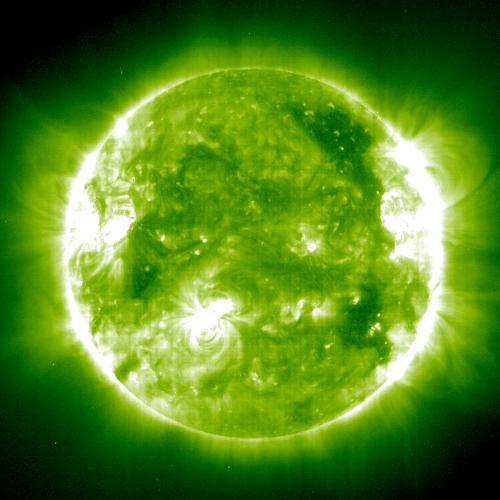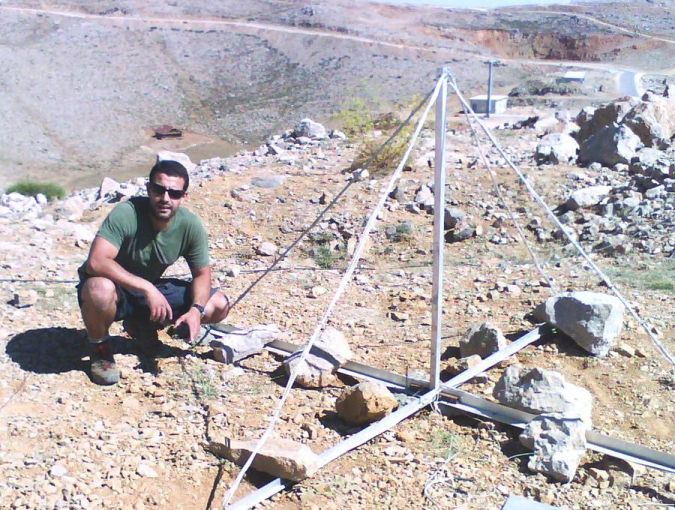Researchers from Tel Aviv University have discovered a new method to monitor the sun's rotation

Tel Aviv. The sunspots, which move in a circular motion on the surface of the sun, can provide us with a large amount of information about our planet. Scientists use them, for example, to measure the time of the sun's rotation around an axis or to make long-term forecasts about the prevailing conditions on Earth.
However, in some years, like this year for example, it is not possible to observe or track these spots accurately. We are currently in a period when "solar activity is at a minimum" with very few, if any, sunspots visible from Earth. This fact poses quite a few problems for scientists who study a new field of science called "Space Weather" and deals with the interaction between the sun and the Earth's environment.
Thanks to the new discovery by Professor Colin Price, head of the Department of Geophysics and Planetary Sciences, and his doctoral student Yuval Reuvani from the Department of Geophysics and Planetary Sciences and the School of Environmental Studies at Tel Aviv University, scientists now have a better and more accurate tool for monitoring the rotation of the Sun in the absence of available sunspots for viewing, and even during their stay. The study was published last month in the scientific journal "Journal of Geophysical Research - Space Physics", and has implications for a better understanding of the interaction between the sun and our planet. The great advantage is that the method is based on measurements of the radiation emitted by lightning here on Earth.
Comes and goes, every 27 days

Using a ring antenna in a triangular configuration - a VLF (Very Low Frequency) antenna which actually receives electromagnetic radiation in a very low frequency range, Professor Price and his research group monitor electrical activity from distant lightning at one of their research stations, which is located at the Solar Energy Research Institute in Sde Boker. With the ability to detect electromagnetic radiation emitted from lightning thousands of kilometers away originating in the African continent, the team of researchers noticed a strange phenomenon in deciphering the information received from the lightning activity, a pattern that appears and disappears every 27 days.
"Although we monitor electrical activity originating from lightning strikes in Africa, seemingly thousands of kilometers away, the radiation emitted from those lightnings interacts with the ionosphere, a layer charged with electric charge that surrounds the Earth at an altitude of 100-60 km, at the same time that it spreads and moves from Africa towards Israel. This radiation is reflected on the one hand from the lower layer of the ionosphere and on the other hand from the ground of the earth and thus they actually "bounce" on the surface of the globe for distances of thousands of kilometers. From the analysis of the data, we noticed that the form of the expansion, during a large number of repetitions, actually moves across the surface of an envelope that originates from the activity of the sun - and changes in a cycle of 27 days. The activity of the distribution of lightning occurs in full timing with the frequency of the sun's rotation around the sun's axis, in some way, dictates the pattern obtained from the energy that is emitted from the lightning."
As we balance to music, or just a sound, from the other side of a lake, the sound wave can spread over a long distance on the surface of the water, and be heard clearly - and at the same time, under other conditions that depend on the percentage of humidity, temperature and wind, be swallowed up and not be heard at all.
A similar effect is observed in the data of the radiation emitted by lightning as a result of changes in the ionosphere caused by the Sun - which oscillates in a 27-day cycle. The team of researchers showed that the 27-day periodic pattern derived from measurements of the electromagnetic energy emitted by lightning does not result from the lightning activity itself, but from changes that occur in the ionosphere on a 27-day time scale.

measure the pulse of the sun
This discovery is a new phenomenon known to science, and Professor Price, a world-renowned climate change scientist, believes it will help scientists formulate new questions about the sun's influence on our climate. "This is a very basic parameter, and very little is still known about it," declares Professor Price. "We know that the earth rotates once every 24 hours, and that the moon rotates once every 27.3 days. But the exact rotation time of the sun, which is a huge ball of gases, remains obscure. Our research provides a new method for monitoring the sun's rotation from a single measuring station in the Negev Desert, a method that proves to be a more powerful and consistent method than the methods commonly used today that are based on observations of the sun's rotation from satellites to determine the time of the sun's rotation and how it changes over time."
How this discovery will affect our lives on Earth, Professor Price does not know. "This is an interesting field that is worth investigating," he says, "as of today, nothing has been done to investigate the relationship between short changes in solar energy as a result of the sun's rotation and climatic patterns.
"Changes in the sun's activity on short time scales can have an effect on the functioning of satellites, the accuracy of navigation systems, the health of astronauts, and even on the power grids here on Earth. Many scientists claim that changes in solar activity are related to changes in climate and weather patterns, so these small changes we notice every 27 days could also be related to small changes in climate or weather patterns.
"Our data can help researchers examine short-term relationships between weather, climate and cycles in solar activity. With the tool we developed we have a good method to follow the pulse of the sun."

6 תגובות
Many scientists claim that changes in the sun's activity are related to changes in climate and weather patterns.
?
Where can I get more information about this?
It is interesting.
Aria, thanks for the clarification and explanation!
There is no new revelation in this publication. I must point out that as a shortwave radio operator who is affected by the ionosphere, I was aware that the quality of communication changes in 11-year cycles (the sunspot cycle), but I was completely unaware of the 27-day cycle. Following this publication, I googled the words "27 days" sun radio hf ionosphere propagation cycle and discovered that the fact that there is an ionospheric cycle that affects radio connections in a cycle of 27 days, is not new. There is no doubt that what is described here is important because of the orderly and documented surveillance, what's more the source of the transmissions here is not in humans but in lightning.
Aria, thanks for the exhaustive explanation!
Maybe this is some kind of ionospheric echo that the earth has been echoing since the time the sun was active?
Below is a more accurate and understandable explanation. They pick up electromagnetic waves (radio waves in this case) originating from distant lightning. They noticed a correlation between the cycle of changes in the absorption intensity of lightning and the rotation of the sun (27 days). The reception is done through reflections from the ionosphere and the strength of the reception depends on the state of the ionosphere. The state of the ionosphere is affected by solar radiation. Hence the connection between the solar cycle and the lightning absorption cycle.